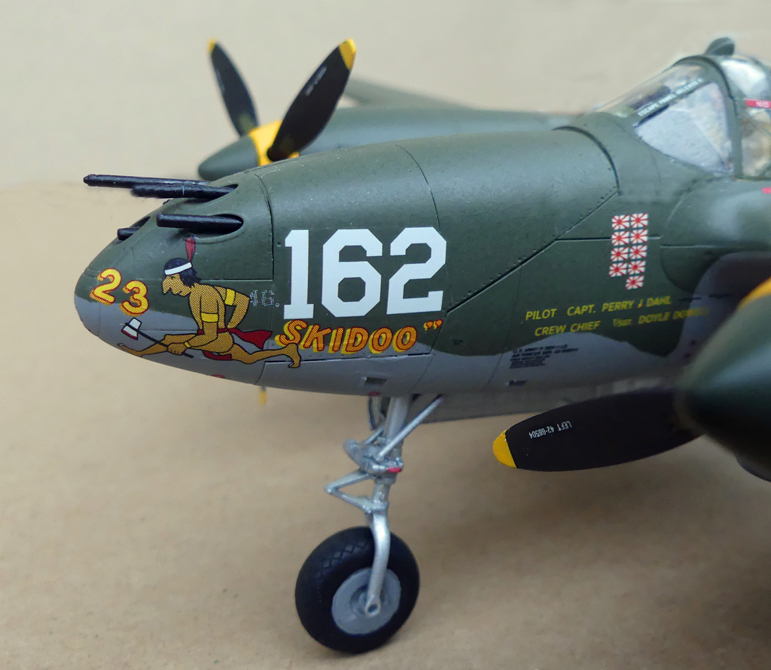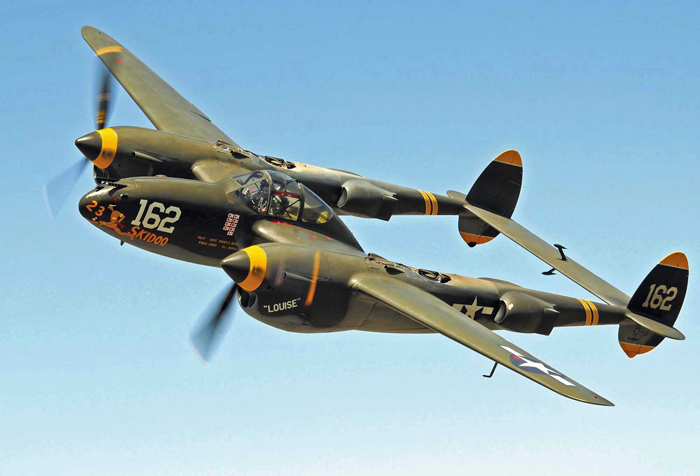

The Lockheed P-38 Lightning is an American single seated, piston-engined fighter aircraft that was in service during World War II. It was designed in 1937 by Clarence "Kelly" Johnson who as a member and first team leader of the Lockheed Skunk Works, played a leading role in the design of over forty aircraft including the U-2 and SR-71. The first flight of the XP-38 was on January 27, 1939.
Developed for the United States Army Air Corps, the P-38 had distinctive twin booms and a central nacelle containing the cockpit and armament. Allied propaganda claimed it had been nicknamed the fork-tailed devil (German: der Gabelschwanz-Teufel) by the Luftwaffe and "two planes, one pilot" by the Japanese. Along with its use as a general fighter, the P-38 was utilized in various aerial combat roles including as a highly effective fighter-bomber, a night fighter, and as a long-range escort fighter when equipped with drop tanks. The P-38 was also used as a bomber-pathfinder, guiding streams of medium and heavy bombers; or even other P-38s, equipped with bombs, to their targets. Used in the aerial reconnaissance role, the P-38 accounted for 90 percent of the aerial film captured over Europe.
Unusual for a fighter of this time, the exhaust was muffled by the turbo-superchargers, making the P-38's operation relatively quiet. The two turbo-superchargers also provided the P-38 with good high-altitude performance, making it one of the earliest Allied fighters capable of performing at such altitudes. It was extremely forgiving and could be mishandled in many ways, but the rate of roll in the early versions was too low for it to excel as a dogfighter.
One reason for the P-38’s success was its clustering of all the armament in the nose. This was unusual in U.S. aircraft, which typically used wing-mounted guns with trajectories set up to crisscross at one or more points in a convergence zone. Nose-mounted guns did not suffer from having their useful ranges limited by pattern convergence, meaning that good pilots could shoot much farther. A Lightning could reliably hit targets at any range up to 1,000 yards (910 m), whereas the wing guns of other fighters were optimized for a specific range.
While seeing action in all theaters of World War II, the P-38 was used most successfully in the Pacific and the China-Burma-India Theaters of Operations. It was credited with destroying more Japanese aircraft than any other USAAF fighter and was the aircraft of America's top aces, Richard Bong (40 victories), Thomas McGuire (38 victories) and Charles H. MacDonald (27 victories).
For a while, the 475th Fighter Group included among its personnel the famous pilot Charles Lindbergh. He was serving with the Group as a technical representative from the United Aircraft Corporation. Lindbergh flew a number of combat missions with the Group in June/August 1944 as a civilian to instruct pilots on how to use cruise control to get maximum range and endurance from their P-38Js. On 28 July, Lindbergh was credited with shooting down a Japanese Mitsubishi Ki-51 over Elpaputih Bay in the Netherlands East Indies in a 433rd Fighter Squadron P-38 42-104995.
The P-38 figured in one of the most significant operations in the Pacific theater: the interception, on 18 April 1943, of Admiral Isoroku Yamamoto, the architect of Japan's naval strategy in the Pacific including the attack on Pearl Harbor. When American codebreakers found out that he was flying to Bougainville Island to conduct a front-line inspection, 16 P-38G Lightnings were sent on a long-range fighter-intercept mission, flying 435 miles (700 km) from Guadalcanal at heights of 10 - 50 ft. (3.0 - 15.2 m) above the ocean to avoid detection. The Lightnings met Yamamoto's two Mitsubishi G4M "Betty" fast bomber transports and six escorting Zeros just as they arrived at the island. The first Betty crashed in the jungle and the second ditched near the coast. Two Zeros were also claimed by the American fighters with the loss of one P-38. Japanese search parties found Yamamoto's body at the jungle crash site the next day.
The P-38 was the only American fighter aircraft in large-scale production throughout American involvement in the war, from Pearl Harbor to Victory over Japan Day. At the end of the war, orders for 1,887 more were cancelled.
Facts and General Characteristics of the P-38H Lightning:
Contractor: Lockheed Corporation
Type: Fighter/bomber
Crew: One
Wingspan: 52 ft. (15.85 m)
Length: 37 ft. 10. In. (11.53 m)
Height: 12 ft 10 in. (3.91 m)
Weight: Empty: 12,800 lbs. (5,806 kg), Max Takeoff: 21,600 lbs. (9,798 kg)
Power Plant: 1 × Allison V-1710-111 V-12 liquid-cooled turbo-supercharged piston
engine, 1,600 hp (1,200 kW) (Left-hand rotation fitted to port)
1 × Allison V-1710-113 V-12 liquid-cooled turbo-supercharged piston engine, 1,600 hp (1,200 kW) (Right-hand rotation fitted to starboard)
Max Speed: 414 mph (666 km/h)
Ceiling: 44,000 ft. (13,000 m)
Range: 1,300 miles (2,100 km)
Armament: 1× Hispano M2(C) 20 mm cannon with 150 rounds
4× M2 Browning machine gun 0.50 in. (12.7 mm) machine guns with 500 rpg
4× M10 three-tube 4.5 in. (112 mm) M8 rocket launchers; or:
Inner hardpoints:
2× 2,000 lb. (907 kg) bombs or drop tanks; or:
2× 1,000 lb. (454 kg) bombs or drop tanks, plus either
4× 500 lb. (227 kg) bombs or:
4× 250 lb. (113 kg) bombs; or:
6× 500 lb. (227 kg) bombs; or:
6× 250 lb. (113 kg) bombs
Outer hardpoints:
10× 5 in. (127 mm) HVARs (High Velocity Aircraft Rockets); or:
2× 500 lb. (227 kg) bombs; or:
2× 250 lb. (113 kg) bombs
Number Built (all variants): 10,037
Number Still Airworthy: 10
Facts and General Characteristics of the Model:
This is a special limited edition “White Box” kit by Tamiya. It included three ball bearing weights to keep the model from tail tipping due to the tricycle landing gear. It also included pre-printed canopy mask stickers that still had to be cut out. The model is very detailed but for the high price, it could have included photo-etched parts for the cockpit. Options included open or closed canopy (I chose closed), the ladder stowed or deployed (I chose stowed) and 150 gallon or 300 gallon fuel drop tanks (I chose the 150 gallon tanks). The model paint and markings represent a P-38H flown by Capt. Perry J. Dahl with the 432nd Fighter Group, 5th Air Force based in Port Moresby, New Guinea, 1944.
Manufacturer: Tamiya, Inc. Japan
Scale: 1/48
Wingspan: 13 in.
Length: 9.4 in.
Height: 2.5 in.
Parts: 195
Decals: 164
Hours to build and paint: 55.5
Mistakes/problems:
1. Most of the parts fit very well and there was no flashing at all but the canopy sections did not fit flush to the fuselage no matter how much I tried cutting and filing.
2. I couldn’t paint the thin silver line between the tire and wheel on the landing gear.
3. I didn’t do a good job painting the pilot as my tiny paint brush was no longer good and some of the paints I used were either too thin or too thick. The paint job shown in the photo of the pilot is slightly enhanced using Photoshop. The pilot can barely be seen through the canopy so I wasn’t too concerned about how he looked.
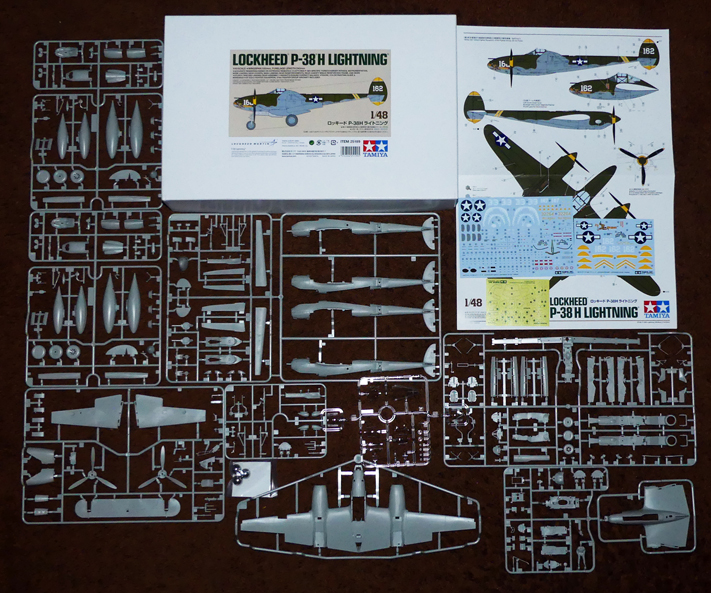
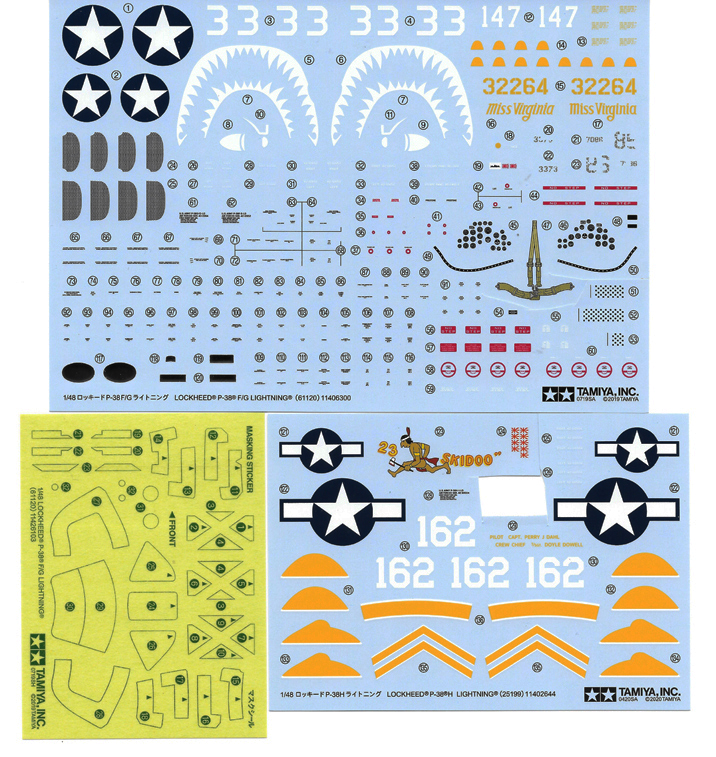
Decals and canopy mask stickers.
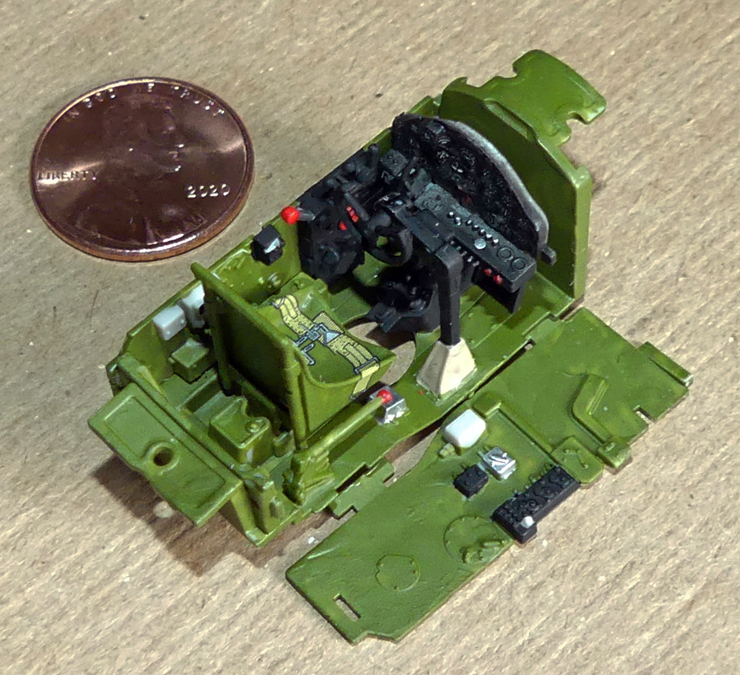
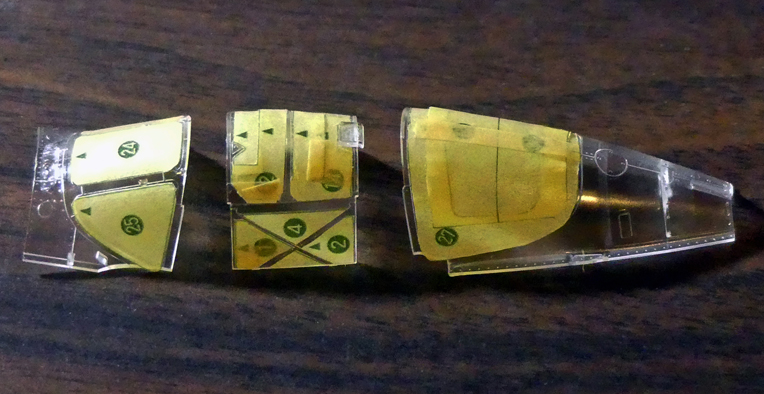
While the printed canopy mask stickers helped, this is still my least favorite task.
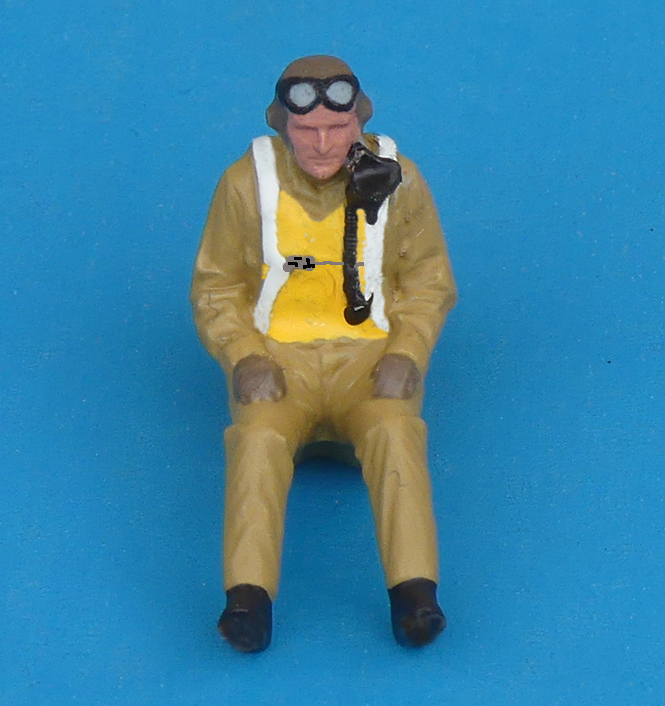
Pilot Capt. Perry J. Dahl

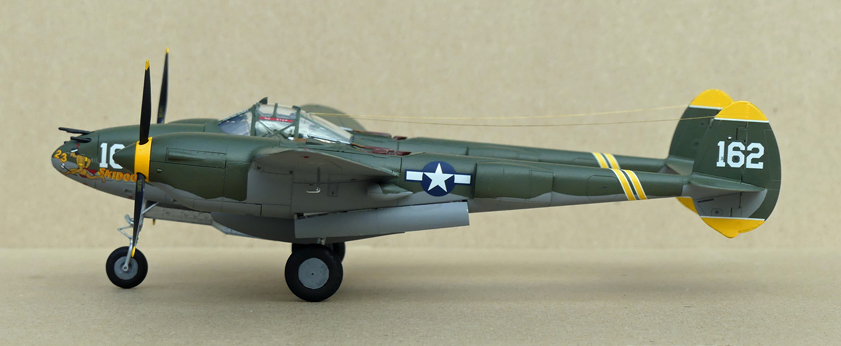



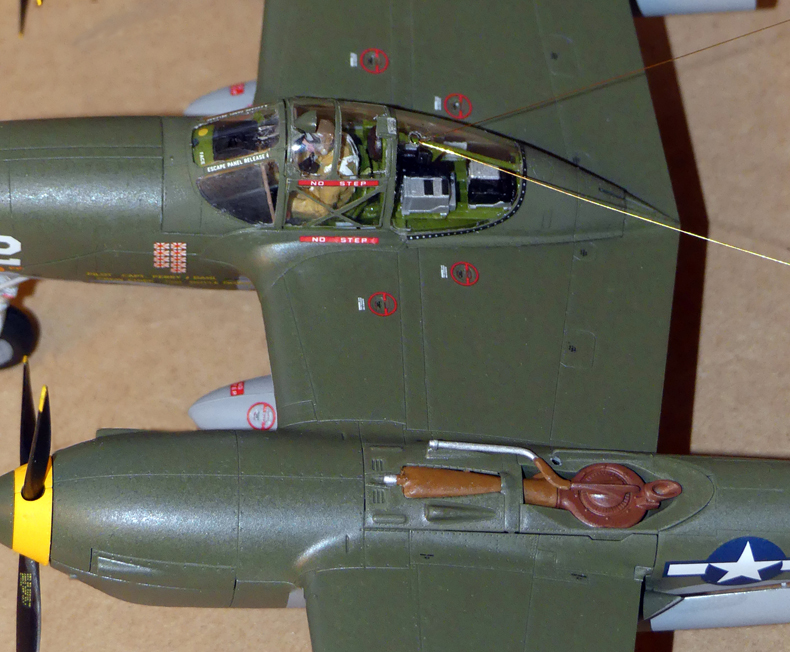
Detail of the canopy and a turbo-supercharger.
